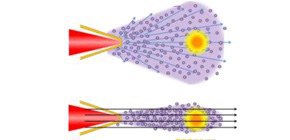
Successful guiding of light-speed electrons using the strongest magnetic field
Will be applied to the reproduction of physical phenomena of the universe and efficient nuclear fusion
An international joint research team of researchers from the Institute of Laser Engineering, Osaka University, Bordeaux University and École Polytechnique (France), Technical University of Madrid (Spain), University of Oxford and University of York (UK), and Technische Universität Darmstadt (Germany), succeeded in efficient guiding of a MeV electron beam through solid-density matter by externally imposing a magnetic field of 600 tesla (T), about 600 times greater than the magnetic energy of a neodymium magnet, while maintaining its high brightness over a long distance, a world first.
By irradiating plasma with high intensity lasers, electrons are accelerated to almost the speed of light. These electrons are referred to as ‘relativistic electron beams (REB).’ One of the applications of REB is 'fast heating,' which heats high-density objects instantly. Fast heating enables ‘Laboratory Astrophysics,’ the investigation of the state of high temperature and high density equivalent to the core of a star in laboratory simulation experiments, as well as ‘Fast Ignition Laser Fusion.’ However, as the REB accelerated by strong lasers has a large divergence angle (typically 100 degrees), it rapidly loses its brightness as the distance increases, which is a critical problem.
In order to perform efficient local heating, the divergence of the REB must be reduced. To confine the propagation of high energy electrons of 1MeV within a space of a few μm, a kilo-tesla-level magnetic field is required. Also, in order to flow REB from its source to the dense core of nuclear fuel along the magnetic field line by using the characteristic that electrically charged electrons may get easily trapped by a magnetic field line, i.e., in order to guide high energy light-speed electrons by magnetic field lines, a kilotesla-level magnetic field is required.
This joint group generated a strong magnetic field of 600T by flowing a large current driven by a high-intensity laser into a coil. This group accelerated the REB under this strong magnetic field and demonstrated that it was possible to transport the REB over 50 μm distance, a relatively long one in this field, without divergence and attenuation. The energy density increased by about a factor of 5 compared to the case without an imposed magnetic field.
This group’s study results will develop a new type of nuclear fusion that combines a magnetic field and lasers. In space plasma physics as well, the interaction between a magnetic field and plasma is important. The use of experimental techniques and simulations developed by this group will also promote the study of fundamental plasma processes in space and the universe.
Abstract
Intense lasers interacting with dense targets accelerate relativistic electron beams, which transport part of the laser energy into the target depth. However, the overall laser-to-target energy coupling efficiency is impaired by the large divergence of the electron beam, intrinsic to the laser–plasma interaction. Here we demonstrate that an efficient guiding of MeV electrons with about 30 MA current in solid matter is obtained by imposing a laser-driven longitudinal magnetostatic field of 600 T. In the magnetized conditions the transported energy density and the peak background electron temperature at the 60-μm-thick target's rear surface rise by about a factor of five, as unfolded from benchmarked simulations. Such an improvement of energy-density flux through dense matter paves the ground for advances in laser-driven intense sources of energetic particles and radiation, driving matter to extreme temperatures, reaching states relevant for planetary or stellar science as yet inaccessible at the laboratory scale and achieving high-gain laser-driven thermonuclear fusion.

Figure 1
To learn more about this research, please view the full research report entitled " Guiding of relativistic electron beams in dense matter by laser-driven magnetostatic fields " at this page of Nature Communications .
Related link

